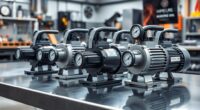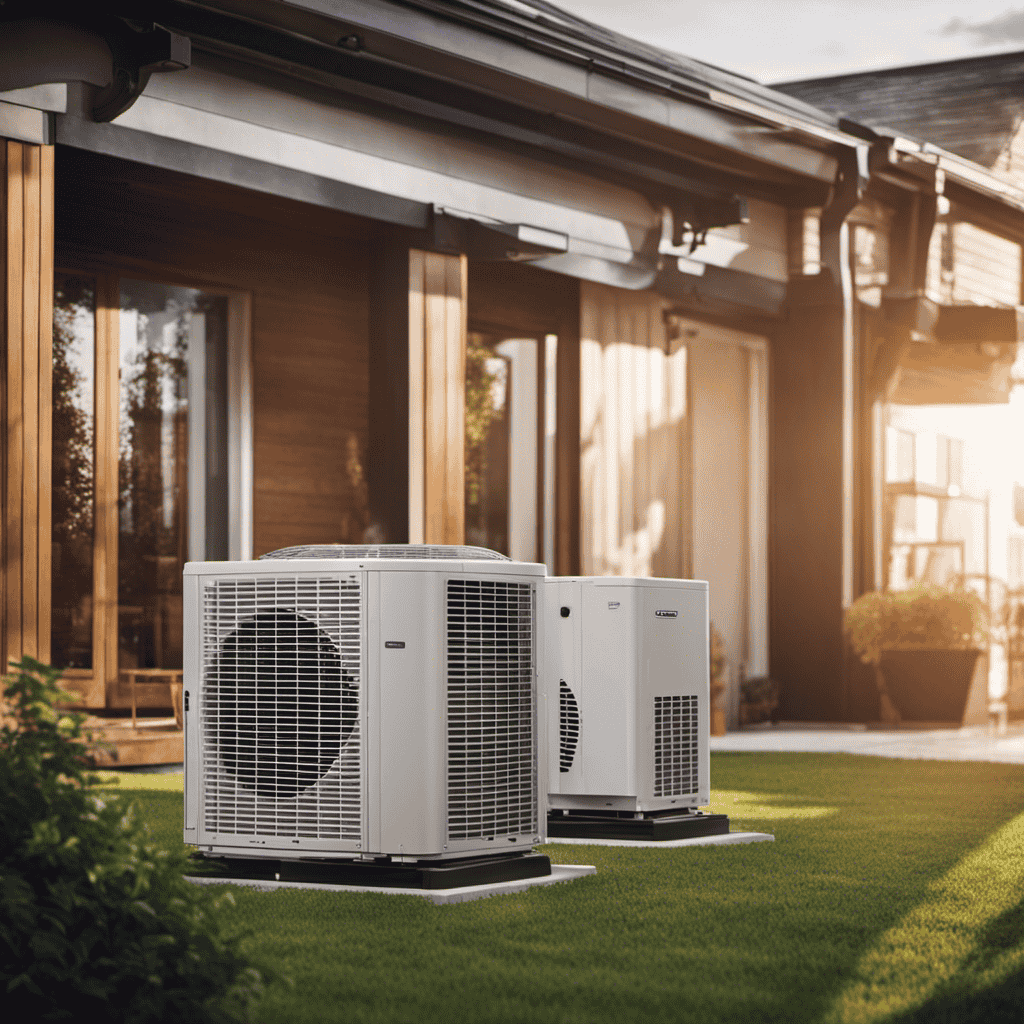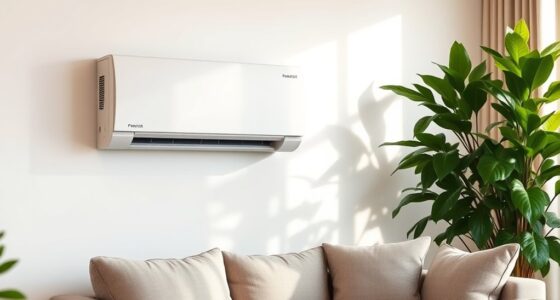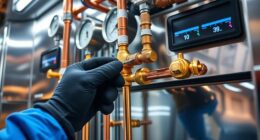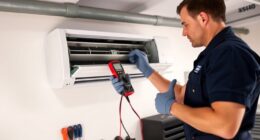Heat pumps are a versatile choice for both heating and cooling in mixed climates by using a reversible refrigerant cycle that transfers heat indoors during winter and outdoors in summer. Modern models, especially those designed for cold weather, can operate efficiently at temperatures as low as -15°F, often with ductless mini-splits for zoning. Combining heat pumps with traditional furnaces improves reliability and efficiency. Keep exploring to see how to optimize your system and save energy year-round.
Key Takeaways
- Reversible refrigerant cycles allow heat pumps to switch seamlessly between heating and cooling modes.
- Cold climate models operate efficiently at outdoor temperatures as low as -15°F, suitable for mixed climates.
- Ductless mini-splits offer targeted heating and cooling without ductwork, effective in variable outdoor temperatures.
- Smart control systems enable automatic switching based on outdoor temperature thresholds for optimal energy use.
- Hybrid systems combine heat pumps with traditional furnaces to ensure reliable heating in extremely cold weather.
How Heat Pumps Provide Both Heating and Cooling
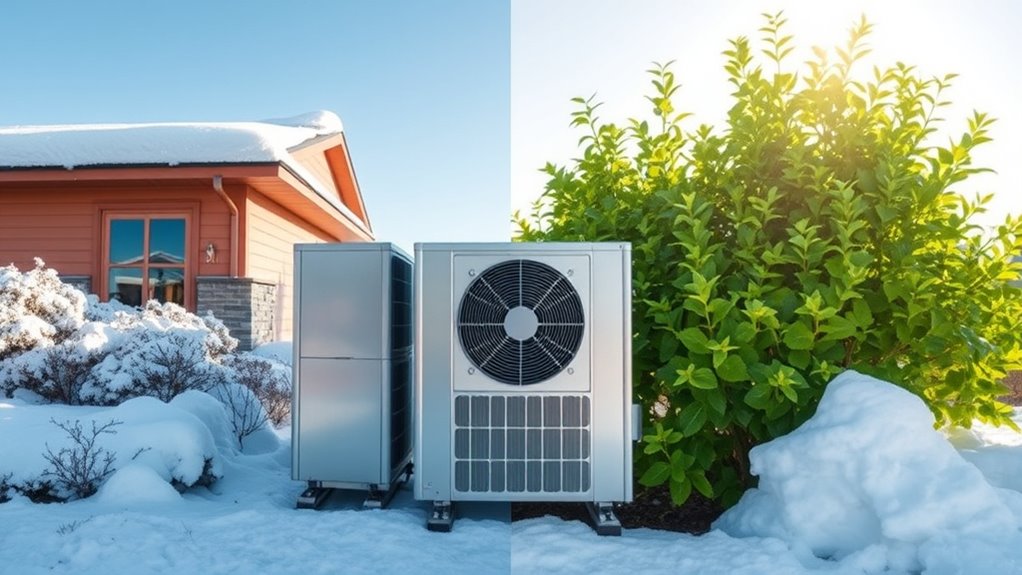
Heat pumps provide both heating and cooling by using a refrigerant cycle that can be reversed as needed. This reversible system allows heat pumps to transfer heat from outdoor air to warm your home during winter and remove indoor heat to cool it in the summer months. They operate by cycling refrigerant through components like an evaporator, compressor, condenser, and expansion valve, enabling efficient heat transfer regardless of outdoor temperatures. During winter, heat is extracted from the outdoor air even at low temperatures, while in summer, heat is expelled outside. The system seamlessly switches between modes, maintaining a comfortable indoor temperature. With high COP values, heat pumps deliver effective climate control year-round, making them ideal for mixed climates that experience both hot and cold seasons. Additionally, proper system sizing can significantly improve the overall performance and energy efficiency of heat pumps in varying weather conditions. Regular maintenance, including filter changes and outdoor unit cleaning, also helps sustain optimal operation and prevent issues such as refrigerant leaks, which can compromise efficiency and increase energy costs.
Types of Heat Pumps Suitable for Mixed Climates
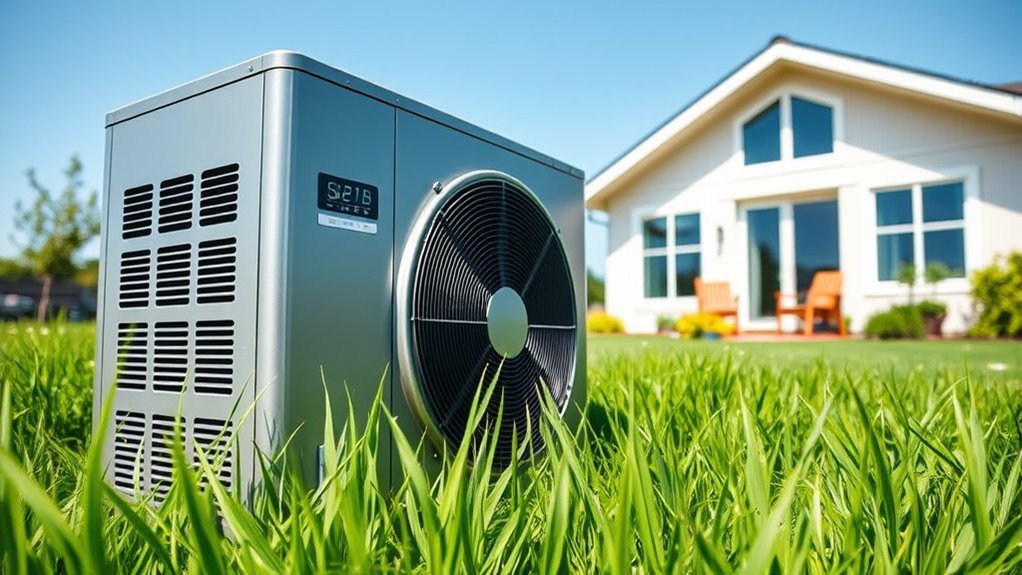
When choosing a heat pump for mixed climates, cold climate models are a smart option, as they work well even in frigid temperatures. Ductless mini-splits offer zone-specific control and are easy to retrofit into existing systems. Additionally, variable-speed compressors adjust their output for peak efficiency and comfort year-round.
Cold Climate Models
Cold climate models of heat pumps are engineered to deliver reliable heating performance even in temperatures as low as -15°F or lower. They often feature inverter-driven compressors, which adjust capacity based on demand, enhancing system efficiency and maintaining a high COP at low outdoor temperatures. Advanced refrigerant systems and defrosting technology prevent frost buildup, ensuring consistent operation during winter months. Some models utilize multi-stage compression, increasing capacity and efficiency when temperatures drop. These innovations allow you to achieve effective heating performance without sacrificing energy efficiency. Proper system sizing and design are essential to optimize performance across seasonal fluctuations. Additionally, smart controls can further enhance efficiency by adjusting operation based on real-time conditions. Incorporating reliable components is vital for maintaining long-term performance in harsh winter conditions. Modern heat pumps also benefit from renewable energy integration, which can further reduce reliance on fossil fuels and lower energy costs. Moreover, selecting models with advanced defrosting technology helps maintain optimal operation during severe winter weather. Overall, cold climate heat pumps provide a dependable heating solution for mixed climates, combining advanced technology with robust performance in harsh winter conditions. For optimal performance, ensuring proper system maintenance can prolong the lifespan and efficiency of these systems.
Ductless Mini-Splits
Ductless mini-split heat pumps offer a flexible and efficient solution for heating and cooling in mixed climates. These systems combine an outdoor condenser with indoor units, providing targeted zoning control without ductwork. Thanks to variable-speed inverter technology, they can adapt their capacity, maximizing energy efficiency with high SEER ratings up to 30 and HSPF over 13. They perform well in cold climates, operating effectively at outdoor temperatures as low as -15°F to -20°F. Their compact indoor units—wall-mounted, ceiling cassette, or floor-mounted—are ideal for retrofit projects and small spaces. With their ability to deliver precise comfort control and reduce energy losses, ductless mini-splits are a smart choice for households seeking reliable, versatile heating and cooling in regions with diverse weather conditions. Incorporating energy-efficient components can further optimize their performance and climate adaptability, ensuring comfort throughout the year. Additionally, advancements in technology integration have enhanced their ability to function seamlessly across different seasons. Proper installation and regular maintenance also play a crucial role in maintaining optimal performance and system longevity.
Variable-Speed Compressors
Variable-speed compressors are essential for heat pumps in mixed climates because they adjust their motor speed based on heating or cooling demands. This modulation capacity allows you to experience:
- Precise temperature regulation, preventing swings even amidst fluctuating seasonal conditions
- Enhanced energy efficiency, as the compressor runs at lower speeds during milder outdoor temperatures
- Better performance optimization, maintaining high COP values in cold weather by gradually reducing compressor speed instead of cycling on and off
- Adaptive control mechanisms enable the system to respond effectively to sudden weather changes, ensuring consistent comfort and efficiency. Additionally, these systems often incorporate smart sensors that improve responsiveness and energy management. This technology relies on refrigerant properties that determine heat absorption and release capabilities, further enhancing system performance. The integration of variable-speed technology also allows for better system longevity by reducing wear and tear caused by frequent cycling.
These features ensure climate control remains consistent, while smart thermostats leverage real-time weather data for ideal operation. By adjusting to outdoor temperatures, variable-speed compressors deliver reliable comfort and reduced energy bills, making them suitable for environments with variable seasonal conditions.
Efficiency Factors and Performance in Varying Temperatures

Heat pump efficiency is highly dependent on outdoor temperatures, with performance peaking at moderate conditions and declining as it gets colder. Your COP drops as outdoor temperature decreases, meaning the heat pump needs more electrical energy to extract heat, reducing efficiency. In cold climates, performance can fall below ideal levels, especially below -5°F to -15°F, requiring auxiliary heating to maintain comfort. Seasonal metrics like HSPF and SEER reflect these fluctuations, showing better efficiency in milder conditions. As outdoor temperatures fluctuate, your heat pump’s seasonal performance varies, impacting operating costs and comfort. Advances in cold-climate technology aim to sustain higher COPs at lower temperatures, improving efficiency and reducing reliance on auxiliary heating during winter. Additionally, wave and wind conditions at beaches can influence outdoor environments, which is important when considering placement and ventilation for heat pumps. Proper system sizing and placement considering climate factors can further optimize performance and energy savings. Understanding these factors and climate adaptation strategies helps you optimize your system’s performance year-round. Proper maintenance and tweaks to refrigerant charge also play a crucial role in ensuring optimal operation across varying temperatures. Furthermore, incorporating insulation techniques can minimize heat loss and enhance overall system efficiency in colder weather.
The Role of Hybrid Systems Combining Heat Pumps and Furnaces
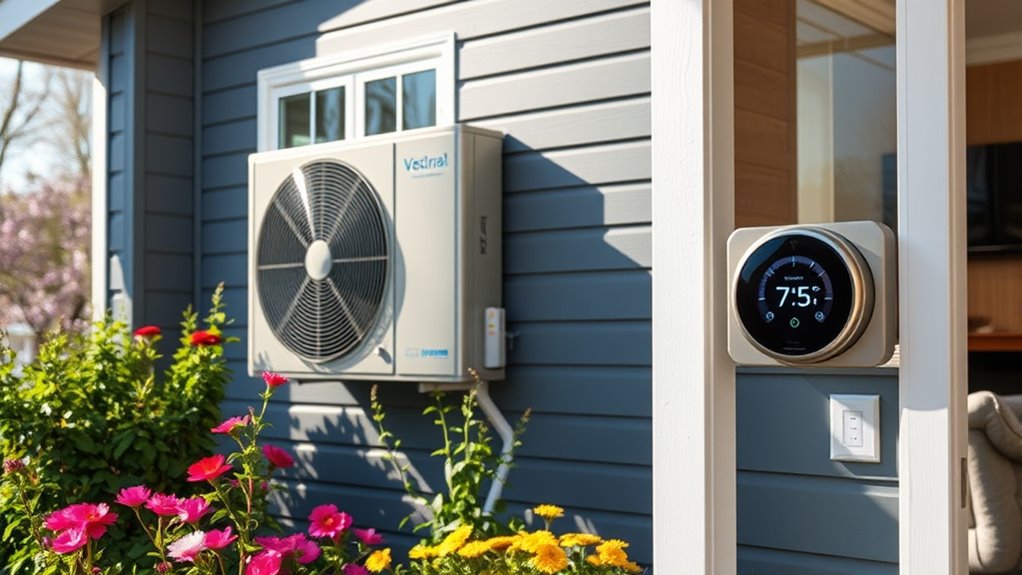
Hybrid systems combine the strengths of heat pumps and furnaces to provide reliable, efficient heating across varying outdoor temperatures. They seamlessly switch between systems based on climate conditions, ensuring ideal temperature management. Here’s how they work for you:
- Use heat pumps during moderate weather to maximize energy efficiency and reduce costs.
- Activate the backup furnace below approximately 40°F (4°C) when heat pumps become less effective.
- Achieve better system integration, maintaining comfort and saving energy during heating and cooling cycles.
Optimizing Energy Use Based on External Conditions

To get the most out of your heat pump, you need to match its operation to outdoor conditions. When temperatures are moderate, the system runs efficiently, but it may switch to backup heating or cooling during extreme weather. Adjusting controls and understanding utility rates can help you save money and keep your home comfortable year-round. Additionally, incorporating advanced tuning techniques can further optimize system performance across varying climates. Regular maintenance can also prevent mechanical failures and ensure consistent operation throughout different seasons. In regions with diverse weather patterns, understanding regional climate influences, such as those documented in Regional Farmhouse Explorations, can provide valuable insights into optimal system operation. Moreover, being aware of sound vibrations and their effects can help in selecting quieter, more effective system components to promote a peaceful environment. Considering energy efficiency standards can guide you toward choosing equipment that performs well in your specific climate while meeting regulatory requirements.
Temperature-Driven System Switching
In mixed climates, smart heat pump systems automatically switch between heating and cooling modes based on outdoor temperatures, guaranteeing efficient energy use throughout the year. By setting appropriate temperature thresholds, the system responds to varying climate conditions. Key factors include:
- Outdoor temperature determines mode switching, with the heat pump operating efficiently above certain points, like 40°F.
- Control systems and smart thermostats facilitate automatic switching, maximizing performance curves for each mode.
- When temperatures drop below thresholds, auxiliary heat kicks in to maintain comfort, balancing heat pump efficiency with cost.
This seamless transition reduces unnecessary energy consumption, leveraging real-time data to adapt to external conditions. Proper configuration guarantees optimal performance, minimizing reliance on less efficient heating sources during extreme cold spells.
Cost-Effective Climate Control
Optimizing energy use in mixed climates involves leveraging outdoor conditions and energy pricing to control heating and cooling efficiently. Heat pumps enhance climate control by switching seamlessly between modes, maximizing energy efficiency. During moderate outdoor temperatures, they deliver ideal seasonal performance, reducing operating costs and increasing energy savings through system optimization. When temperatures drop below the ideal range, supplementing with alternative heating sources maintains cost reduction without sacrificing comfort. Timing operations during off-peak electricity rates further improves efficiency and lowers expenses. Proper temperature management, including intelligent thermostats and system sizing, ensures heat pumps respond dynamically to external conditions. By tailoring operation based on outdoor weather and energy costs, you can achieve cost-effective climate control that balances comfort with minimal energy consumption.
Rate Structures and Their Impact on Operating Costs

Rate structures play a pivotal role in determining the operating costs of heat pumps, especially since different pricing schemes can either encourage or discourage electrification. Tiered rates, like those in Fort Collins, can increase costs during high usage with surcharges, raising operating expenses. Conversely, non-tiered rates, which are about 0.77 cents per kWh higher than Tier 1, offer steady electricity rates, making electric systems more economical. Off-peak pricing reduces energy costs during low-demand hours, improving COP and lowering overall expenses. On the other hand, peak rates—often markedly higher—can push heat pump operation above the cost of fossil-fuel systems unless COPs reach 7.4 to 8.2. Understanding these utility rate structures helps you optimize operating costs and maximize efficiency.
Environmental Benefits and Emission Reductions

Heat pumps offer a substantial environmental advantage by markedly reducing greenhouse gas emissions compared to traditional systems. When powered by renewable electricity, they boost energy efficiency and lower your carbon footprint. Fully electric heat pumps can cut CO₂ emissions by up to 67%, depending on the energy sources used. This reduction lessens climate impact during both heating and cooling seasons. As grids become cleaner, the environmental benefits grow, making heat pumps an effective choice for reducing greenhouse gases. Here’s a quick comparison:
| Aspect | Traditional Systems | Heat Pumps | Environmental Impact |
|---|---|---|---|
| CO₂ Emissions | High, fossil fuel-based | Up to 67% reduction | Significantly lower emissions |
| Energy Efficiency | Moderate to low | High | Greater reduction in emissions |
| Climate Impact | Greater contribution | Lower contribution | Reduced overall climate impact |
| Renewable Electricity | Less dependent on renewables | Optimized with renewables | Enhanced environmental benefits |
Making the Transition: What to Consider Before Installing

Before installing a heat pump, it’s essential to evaluate whether your climate supports efficient year-round heating and cooling. Consider these factors:
- Check outdoor temperature thresholds to guarantee your hybrid system switches smoothly from heat pump to backup furnace, typically around 40°F to 25°F.
- Assess your utility rate structure; off-peak pricing and non-tiered rates can enhance system efficiency and reduce energy costs.
- Improve insulation and sealing to maximize heat pump performance, especially in colder months, and select a system with COP ratings of at least 3.0 for maximum efficiency.
Understanding climate considerations and system efficiency helps you make a smart choice, guaranteeing comfort and savings while reducing environmental impact.
Frequently Asked Questions
Can a Heat Pump Be Used for Both Heating and Cooling?
Yes, you can use a heat pump for both heating and cooling. It works by reversing the refrigerant flow through a reversing valve, allowing it to switch between cooling and heating modes seamlessly. During summer, it cools your home by removing heat, and in winter, it warms your space by extracting heat from outside air. This versatility makes heat pumps an efficient all-in-one solution for year-round climate control.
Is a Dual Fuel HVAC System Worth It?
A dual fuel HVAC system can be worth it if you live in a climate with wide temperature swings. It combines a heat pump and a furnace, switching between them to save energy and lower costs. You’ll benefit from reliable heating in extreme cold and energy savings in milder weather. Although the upfront cost is higher, the long-term savings and comfort can make it a smart investment for your home.
What Is a Dual Heating and Cooling System?
A dual heating and cooling system is a single, reversible heat pump that handles both functions seamlessly. It switches between heating and cooling modes by reversing refrigerant flow, allowing you to warm your home during cold months and cool it when it’s hot. This system simplifies your setup, reduces space needs, and offers energy-efficient comfort all year round, making it an ideal solution for varied seasonal climates.
What Is a Hybrid Heating and Cooling System?
A hybrid heating and cooling system combines a heat pump with a traditional furnace or boiler. You’ll find it automatically switches between the two, depending on outdoor temperatures. During milder weather, it uses the heat pump for energy savings, but when it gets really cold, it activates the backup furnace to keep your home comfortable. This setup maximizes efficiency and reduces your energy costs year-round.
Conclusion
Embracing heat pumps in your home is like planting a versatile tree that offers shade in summer and warmth in winter, transforming your climate challenges into a harmonious balance. With the right system, you’ll navigate fluctuating temperatures smoothly, like a skilled sailor adjusting sails to the wind. By choosing wisely and optimizing your setup, you’ll create a cozy haven that’s both eco-friendly and cost-effective—making every season feel like a gentle, inviting embrace.

